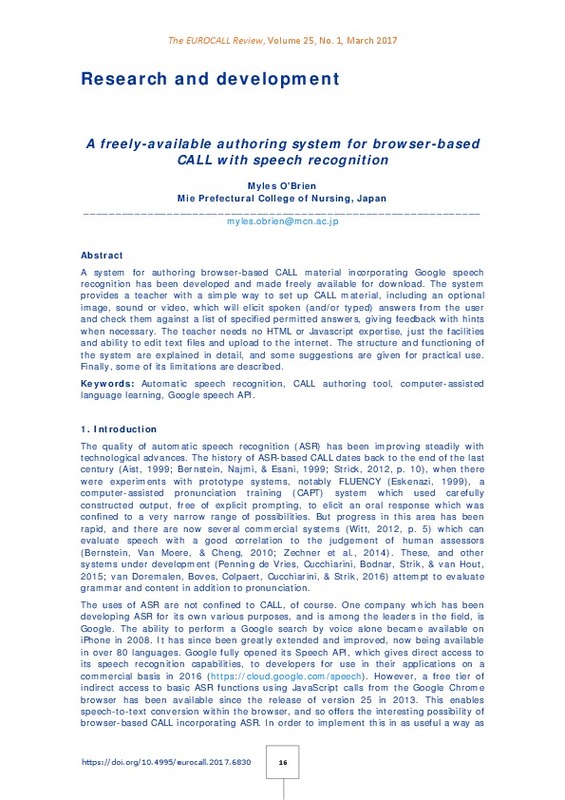JavaScript is disabled for your browser. Some features of this site may not work without it.
Buscar en RiuNet
Listar
Mi cuenta
Estadísticas
Ayuda RiuNet
Admin. UPV
A freely-available authoring system for browser-based CALL with speech recognition
Mostrar el registro sencillo del ítem
Ficheros en el ítem
| dc.contributor.author | O'Brien, Myles
|
es_ES |
| dc.date.accessioned | 2017-07-04T10:38:01Z | |
| dc.date.available | 2017-07-04T10:38:01Z | |
| dc.date.issued | 2017-04-28 | |
| dc.identifier.uri | http://hdl.handle.net/10251/84412 | |
| dc.description.abstract | [EN] A system for authoring browser-based CALL material incorporating Google speech recognition has been developed and made freely available for download. The system provides a teacher with a simple way to set up CALL material, including an optional image, sound or video, which will elicit spoken (and/or typed) answers from the user and check them against a list of specified permitted answers, giving feedback with hints when necessary. The teacher needs no HTML or Javascript expertise, just the facilities and ability to edit text files and upload to the Internet. The structure and functioning of the system are explained in detail, and some suggestions are given for practical use. Finally, some of its limitations are described. | es_ES |
| dc.language | Inglés | es_ES |
| dc.publisher | Universitat Politècnica de València | |
| dc.relation.ispartof | The EuroCALL Review | |
| dc.rights | Reconocimiento - No comercial - Sin obra derivada (by-nc-nd) | es_ES |
| dc.subject | Automatic speech recognition | es_ES |
| dc.subject | CALL authoring tool | es_ES |
| dc.subject | Computer assisted language learning | es_ES |
| dc.subject | Google speech API | es_ES |
| dc.title | A freely-available authoring system for browser-based CALL with speech recognition | es_ES |
| dc.type | Artículo | es_ES |
| dc.date.updated | 2017-07-04T10:29:31Z | |
| dc.identifier.doi | 10.4995/eurocall.2017.6830 | |
| dc.rights.accessRights | Abierto | es_ES |
| dc.description.bibliographicCitation | O'brien, M. (2017). A freely-available authoring system for browser-based CALL with speech recognition. The EuroCALL Review. 25(1):16-25. https://doi.org/10.4995/eurocall.2017.6830 | es_ES |
| dc.description.accrualMethod | SWORD | es_ES |
| dc.relation.publisherversion | https://doi.org/10.4995/eurocall.2017.6830 | es_ES |
| dc.description.upvformatpinicio | 16 | es_ES |
| dc.description.upvformatpfin | 25 | es_ES |
| dc.type.version | info:eu-repo/semantics/publishedVersion | es_ES |
| dc.description.volume | 25 | |
| dc.description.issue | 1 | |
| dc.identifier.eissn | 1695-2618 | |
| dc.description.references | Aist, G., (1999). Speech recognition in Computer-Assisted Language Learning. In Cameron, K. (Ed.), CALL: Media, design & applications (pp. 165-181). Lisse: Swets & Zeitlinger. | es_ES |
| dc.description.references | Bernstein, J., Najmi, A., Ehsani, F. (1999). Subarashii: Encounters in Japanese Spoken Language Education. CALICO Journal, 16(3), 361-384. Retrieved from https://calico.org/html/article_619.pdf. | es_ES |
| dc.description.references | Bernstein, J., Van Moere, A., & Cheng, J. (2010). Validating automated speaking tests. Language Testing, 27(3), 355-377. doi:10.1177/0265532210364404 | es_ES |
| dc.description.references | Ellis, R. (2008). A typology of written corrective feedback types. ELT Journal, 63(2), 97-107. doi:10.1093/elt/ccn023 | es_ES |
| dc.description.references | Eskenazi, M. (1999). Using automatic speech processing for foreign language pronunciation tutoring: Some issues and a prototype. Language Learning & Technology, 2(2), 62-76. | es_ES |
| dc.description.references | Golonka, E. M., Bowles, A. R., Frank, V. M., Richardson, D. L., & Freynik, S. (2012). Technologies for foreign language learning: a review of technology types and their effectiveness. Computer Assisted Language Learning, 27(1), 70-105. doi:10.1080/09588221.2012.700315 | es_ES |
| dc.description.references | Guénette, D. (2007). Is feedback pedagogically correct? Journal of Second Language Writing, 16(1), 40-53. doi:10.1016/j.jslw.2007.01.001 | es_ES |
| dc.description.references | Levy, M. & Stockwell, G. (2006). CALL dimensions: Options and issues in computer-assisted language learning. Mahwah, NJ: Lawrence Erlbaum Associates. | es_ES |
| dc.description.references | Munro, M. J. (2011). Intelligibility: Buzzword or buzzworthy? In. J. Levis & K. LeVelle (Eds.). Proceedings of the 2nd Pronunciation in Second Language Learning and Teaching Conference, Sept. 2010. (pp.7-16),Ames,IA: Iowa State University. Retrieved from http://jlevis.public.iastate.edu/2010%20Proceedings%2010-25-11%20-%20B.pdf | es_ES |
| dc.description.references | De Vries, B. P., Cucchiarini, C., Bodnar, S., Strik, H., & van Hout, R. (2014). Spoken grammar practice and feedback in an ASR-based CALL system. Computer Assisted Language Learning, 28(6), 550-576. doi:10.1080/09588221.2014.889713 | es_ES |
| dc.description.references | Strick, H. (2012). ASR-based systems for language learning and therapy. In O. Engwall (Ed.), Proceedings of the International Symposium on Automatic Detection of Errors in Pronunciation Training (pp. 9-20). Retrieved from http://www.speech.kth.se/isadept/ISADEPT-proceedings.pdf. | es_ES |
| dc.description.references | Van Doremalen, J., Boves, L., Colpaert, J., Cucchiarini, C., & Strik, H. (2016). Evaluating automatic speech recognition-based language learning systems: a case study. Computer Assisted Language Learning, 29(4), 833-851. doi:10.1080/09588221.2016.1167090 | es_ES |
| dc.description.references | Witt, S.M. (2012). Automatic Error Detection in Pronunciation Training: Where we are and where we need to go. In O. Engwall (Ed.), Proceedings of the International Symposium on Automatic Detection of Errors in Pronunciation Training (pp. 1-8). Retrieved from http://www.speech.kth.se/isadept/ISADEPT-proceedings.pdf. | es_ES |








